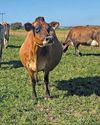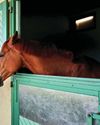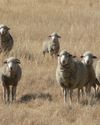試す 金 - 無料
Shining fluorescent light on bee sperm could help explain colony survival
Farmer's Weekly
|Farmer's Weekly 19 August 2022
Christina Kotze, a researcher in invertebrate reproductive biology at the University of the Western Cape (UWC), and Gerhard van der Horst, emeritus professor at UWC, describe how pioneering methods of analysis developed by UWC's comparative spermatology group may ultimately be used to save the world's honeybees.
-

FAST FACTS
Honeybees, which play a key role in the pollination of plants, including food crops, are dying off for reasons not fully understood.
Many scientists think that poor sperm quality, perhaps caused by environmental stressors, may be the main reason for so-called colony collapse.
Researchers at the University of the Western Cape are combining fluorescent microscopy and sperm analysis to study bee health and identify potential environmental stressors.
Form follows function. This is the principle that the design or shape of something, whether made by humans or in nature, should serve a purpose.
Honeybees' function is to pollinate plants, make honey, survive and reproduce. Along with other pollinators (birds, moths, butterflies, bats and many more) they are the unsung forces behind much of what people eat, drink and even wear. Animal pollinators are said to contribute to the production of 87 global crops in 200 countries, including 30% of the world's food crops. Their labours have been valued at around €153 billion (about R2,6 trillion).
But in one review paper, researchers suggest that at current rates of decline, the world will lose some 40% of its insect species, including bees, over the next few decades. Among the causes are widespread use of pesticides and habitat loss.
Bee colonies worldwide are collapsing. A 2012 to 2014 survey by the European Commission (the first of its kind) estimated that some countries were losing as many as a third of their colonies every year.
The threats to their survival make it urgent to understand the relationship between form and function in honeybees, particularly the sperm of the male bees (drones), the 'flying genitalia' of the bee world, as one researcher described them. That's because of the way bees mate and reproduce.
このストーリーは、Farmer's Weekly の Farmer's Weekly 19 August 2022 版からのものです。
Magzter GOLD を購読すると、厳選された何千ものプレミアム記事や、10,000 以上の雑誌や新聞にアクセスできます。
すでに購読者ですか? サインイン
Farmer's Weekly からのその他のストーリー
Farmer's Weekly
Farmers 'unilateral victims' of climate
Gyeongbuk Provincial Council member Choi Taerim has demanded immediate and substantial support for apple farmers in the South Korean province, urging immediate measures for apple farmers affected by heat damage be implemented, The Asia Business Daily recently reported.
1 min
November 21-28, 2025

Farmer's Weekly
Top agri workers celebrated in the Western Cape
Shannon Robertson, assistant livestock manager at Boschendal near Franschhoek, was crowned the overall winner of the 2025 Western Cape Prestige Agri Awards, held in Durbanville.
1 min
November 21-28, 2025

Farmer's Weekly
Smart dairying: running Jerseys on pasture
The dairy farming sector has seen innovation in milk parlour and cow comfort technology that have allowed farmers to not only yield higher volumes, but extend the productive lifespan of their cows. Albrecht de Jager told Henning Naudé about his approach to maintaining a pasture-raised Jersey herd while utilising precise data measuring technology to ensure quality milk output and optimal cow comfort.
6 mins
November 21-28, 2025

Farmer's Weekly
High-performance dairy farming in the Eastern Cape: the Rufus Dreyer approach
Dairy farming is often described as one of the most technically demanding and strategically complex branches of agriculture.
6 mins
November 21-28, 2025

Farmer's Weekly
Design your stables and camps to assist in AHS control
Keep horses away from areas where disease-carrying midges multiply, like natural pools, lakes, streams and dams, advises Dr Mac.
2 mins
November 21-28, 2025

Farmer's Weekly
The rolling chant that has echoed through SA over the past 30 years
Johan van der Nest is renowned in auction circles and was the first freelance stud-stock auctioneer to begin operating in South Africa.
10 mins
November 21-28, 2025

Farmer's Weekly
Flight from the Red Army
The fall of the Third Reich in 1945 was defined by the Red Army's brutal invasion of Germany. Mike Burgess tells how the Hoppe family trekked from Finowfurt near Berlin to Preetz in Schleswig-Holstein to escape the brutality.
6 mins
November 21-28, 2025

Farmer's Weekly
How to plan a pre-sale feeding programme
Proper feeding of animals before a sale can help producers catch the eye of buyers and increase profits, but it is important to choose the right ration.
8 mins
November 21-28, 2025

Farmer's Weekly
How women are transforming coffee production in Kenya
A group of Kenyan smallholder women farmers are transforming the country's high-value coffee sector by pooling their resources.
5 mins
November 21-28, 2025

Farmer's Weekly
Tough times ahead for SA's grain farmers
Grain farmers face a difficult year ahead with lower grain prices and high production costs
3 mins
November 21-28, 2025
Translate
Change font size
